Abstract
Vegetation slope protection plays an important role in improving the slope stability and protecting the environment. In this study, the mechanical properties of root–soil composites in different growth periods and their effects on slope stability were investigated. First, the shear strength of undisturbed root–soil composites associated with Cynodon dactylon (C.d), Magnolia multiflora (M.m) and grass and shrub mixture (G.s) were measured by large direct shear tests. Then, the effects of plant reinforcement in different growth periods on slope stability were analyzed using ABAQUS. The results show that the shear strength of the root–soil composites were significantly higher than that of the unreinforced soil. The root–soil composites met the Mohr–Coulomb criterion. The shear strength of the three root–soil composites increased first and then decreased during the vegetation growth period. The calculation results show that the factor of safety (FS) of the bare slope was 1.482. The FS values of the C.d, M.m, and G.s slopes were 1.601, 1.658 and 1.715, which increased by 8%, 11.9% and 15.7% compared to the bare soil slopes. Therefore, vegetation could significantly improve slope stability, especially the grass–shrub mixture model. This could provide a rational basis for designing and constructing plant slope protection.
1. Introduction
With the rapid development of highways, railways, bridges, hydropower, tunnel and mining fields, engineered slope failures are more likely to be triggered, leading to soil erosion, collapse, landslides and debris flow [1]. This seriously restricts the safety of the project and directly threatens the safety of people and property. Shallow landslides are a common natural geological disasters [2]. As an important ecological protection measure, vegetation has been used more and more [3,4,5]. Recently, mechanical functions such as shallow-root strengthening and deep-root anchoring were used to improve the erosion resistance and shear strength of the root–soil composite. Plant roots can effectively enhance the shear strength of slope soil, thus improving slope stability [6,7,8]. However, the mechanism of protecting a slope remains to be studied.
At present, the stability of a vegetated slope is mainly studied through experimental research, theoretical analysis, numerical simulation and other methods [9]. The determination of the shear strength parameters of root–soil composites is of great importance, which is commonly conducted by remolding root–soil composites or testing in situ [10]. Comparably, the latter is more in line with natural conditions and is widely accepted by most researchers [11]. Xing et al. [12] studied the influence of vegetation roots on soil shear strength by direct in situ shear testing. Xiong et al. [13] performed in situ shear tests to evaluate the effect of vegetation roots on the shear strength of soils. It is generally accepted that slope stability can be improved by the reinforcement effect of plant roots [14,15]. Mohsen et al. [16] confirmed that vegetation could effectively reduce shallow landslides but had limited influence on deep landslides. Fattet et al. [17] studied the relationship between soil aggregate stability and shear strength under different dominant plant species through direct shear tests. Hu et al. [18] carried out indoor straight shear and triaxial compression tests with different plants, which showed that the cohesion of the root–soil complex was significantly higher than that of plain soil. Loades et al. [19] showed that the shear strength of soil increased with the increase in planting density. Huang et al. [20] studied the influence of roots on the soil shear strength of collapsing walls by direct shear tests. On the other hand, numerical simulations have also been widely adopted to study vegetated slope stability due to their considerable advantages in terms of time, cost and repeatability. Many scholars have adopted the strength reduction method (SRM) such as Lin et al. [21], Sun et al. [22], and Zou et al. [23]. However, the effectiveness of vegetation on slope stability is considerably affected by time. Namely, the different growth periods of plants affect the reinforcement of roots on the soil. Therefore, this paper considers the effects of different growth periods on plant root reinforcement.
In this study, the shear strengths of root–soil composites during different growth periods and their effects on slope stability were investigated using laboratory experiments and finite element methods. The samples containing C.d and M.m roots were obtained from C.d and M.m planted on a slope, and the shear strengths during the different growth periods were measured. The effect of the plants on slope stability over time was investigated through numerical simulations.
2. Materials and Methods
2.1. Materials
2.1.1. Vegetation
Cynodon dactylon (C.d) and Magnolia multiflora (M.m) were chosen as the reinforcing plants, which are widely distributed in central China. C.d and M.m belong to the perennial herb of the Gramineae family and perennial shrub of leguminous Magnolia, respectively.
The seeding density of C.d, M.m and the grass and shrub mixture (G.s) was 20 g/m2. The mixing ratio of the grass and shrub mixture for the G.s slope was 1:5. After selecting the plant seeds, the weighted C.d and M.m were placed in aluminum boxes for planting. The compound fertilizer was completely dissolved in water at 10 g/L and then poured evenly onto each test slope as a base fertilizer. Finally, the seeds were covered with a layer of 1 mm thick soil and evenly covered with spray.
2.1.2. Soil
The planting soil used in the tests was clay soil, which was taken from Hubei University of Technology in Wuhan City. The soil samples were air-dried at room temperature and then ground to pass through a 0.075 mm sieve. The physical properties of the test soil are shown in Table 1. The non-uniformity coefficient of the soil was 3.39, and the coefficient of curvature was 1.62, indicating that the filling particles were relatively uniform.

Table 1.
Basic physical properties of the soil used in the tests.
2.2. Direct Shear Tests
The sampling occurred at 30, 60, 90 and 120 days after germination. Before sampling, the aboveground stems and leaves were cut off. Then, the specimens of bare soil and root–soil composites were carefully sampled using a standard wooden sampler (length 300 mm × width 300 mm × height 90 mm). Each plant slope had four soil specimens at each growing period. A total of 52 specimens were sampled, including 4 samples for the bare slope.
The direct shear test was carried out using the STJY-5-type soil engineering composite direct shear apparatus manufactured by Zhejiang Geotechnical Instrument Manufacturing Company in Hangzhou, China (Figure 1a). The instrument has a horizontal displacement accuracy of 0.01 mm and a range of 0–30 mm. The tester was composed of two shear boxes, a horizontal loading system, a vertical loading system with a measuring system, and a control display screen. The shear box was 300 × 300 × 60 mm with a high-precision electrical motor. Four normal stresses of 50, 100, 150 and 200 kPa were used. The direct shear tests were conducted at a speed of 1 mm/min. At the end of the test, the maximum shear stresses were recorded. If no shear peak was present, as hear stress with a displacement of 18 mm was adopted.
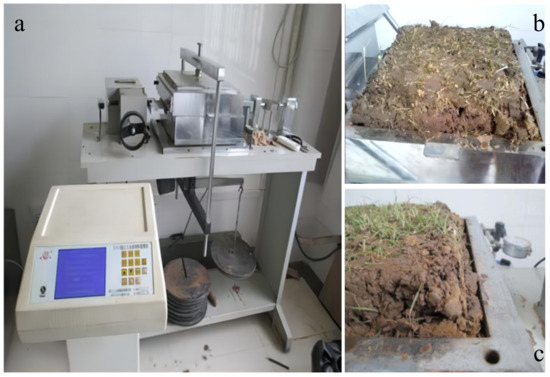
Figure 1.
Direct shear test. (a) Direct shear device; (b) after setting the sample; (c) after sample destruction.
The cohesion and internal friction angles were calculated according to the Mohr–Coulomb criterion as follows:
where τ is the shear strength (kPa), σ is the normal stress acting on the failure surface (kPa), c is the cohesion (kPa), and is the angle of internal friction (°).
3. Test Results
3.1. Shear Strength of the Root–Soil Composites during Different Growth Periods
The shear strength τ of the root–soil composites during the different growth periods was measured by a large direct shear test, as presented in Figure 2. It was obvious that the G.s mixture had the highest τ under the four normal stresses while bare soil held the lowest. Specifically, the τ associated with C.d reached a peak at 90 d and then decreased slightly. M.m had the highest τ at 90 d under normal stress conditions of 50 kPa, 100 kPa and 150 kPa. However, under normal stress conditions of 200 kPa, the τ was highest at 120 d. However, under the same normal stress, the τ first increased and then decreased with the increasing growth cycle. The τ of the G.s mixture under a normal stress of 200 kPa for 90 d was slightly lower than that for 60 d. Except for the 30 d, 60 d and 120 d growth periods, the G.s mixture had the highest τ at 90 d under the normal stress conditions of 50 kPa, 100 kPa and 150 kPa. The τ of the G.s mixture and M.m had the same change trend. As the vegetation growth period increased, the τ increased first and then decreased between 90 and 120 days. Obviously, the presence of roots significantly enhanced the shear strength of the soil. The root–soil composite improved the τ of the soil through a reinforcement mechanism similar to that of conventional reinforcement materials in reinforced soil. Specifically, the roots interacted with the soil to enhance its strength, resulting in an increase in the τ of the composite compared to bare soil [15]. Under different normal stresses, the τ of the bare soil was less than that of the root–soil composites, which shows that plant roots have a reinforcing effect on soil. The greater the τ of the root–soil composite, the greater the benefit to slope stability. Among the plants tested, the root–soil composite containing the G.s mixture generally exhibited a higher τ than that of the C.d and M.m under the same normal stresses. Additionally, the reinforcement effect of the different root systems on the soil varied with the growth period. For the 30 d growth period, the τ of the root–soil composites in order was G.s > M.m > C.d. For the 60 d growth period, the reinforcement effects of the three root systems under different normal stresses had no obvious trends. When the growth period reached 90 and 120 days, the plant growth was stable, and the strengthening effects of all three root systems followed the order G.s > C.d > M.m.
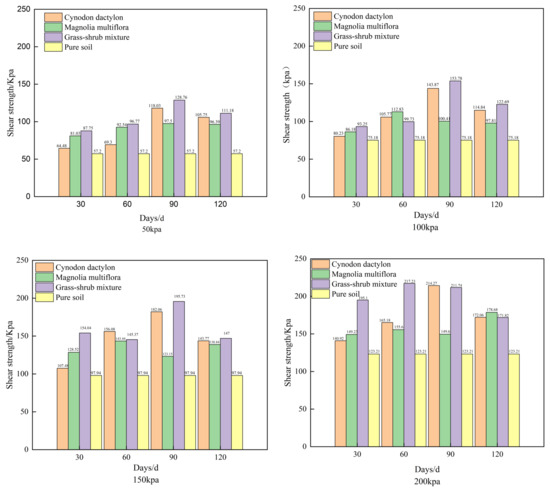
Figure 2.
Shear strength under four normal stresses during the different growth periods.
Overall, the presence of roots significantly enhanced the shear strength of the soil, and the reinforcement effect varied with the type of plant and its growth period. The root–soil composite containing the G.s mixture was a more effective way to improve slope stability compared to using single herb or shrub root reinforcement.
3.2. Root–Soil Composite Shear Strength Characteristics
The coordinates of the shear strength and fitting lines were plotted according to the Mohr–Coulomb theory, as shown in Figure 3. Accordingly, the internal friction angle φ and cohesion c were obtained as shown in Table 2. The corresponding linear regression equations and correlation coefficients R2 are also given.

Figure 3.
Fitting curves associated with the different plants. (a) C.d; (b) M.m; and (c) G.s.

Table 2.
The linear regression equation and correlation coefficients of the shear strength and normal stress in the different growth periods (R2).
It can be seen from Table 2 that the c and φ of the undisturbed bare soil are 33.2 kPa and 23.8°, respectively. Comparably, the c of the root–soil composites during the different growth periods of C.d., M.m and G.s ranged from 34.1 kPa to 82.8 kPa, 49.5 kPa to 72.9 kPa, and 36.8 kPa to 99.8 kPa, respectively. The φ in the different growth periods of C.d., M.m and G.s ranged from 24.5° to 34.1°, 19.7° to 29.9° and 22.4° to 39.1°, respectively. Clearly, all c values of the root–soil composites were higher than bare soil, but the differences in φ were not as obvious. For the root–soil composites, c increased and then decreased initially with the increasing growth period. At 90 d and 120 d, the order of c was G.s > C.d > M.m. The maximum c of the G.s root–soil composite was 99.8 kPa at 90 d, which is about three times that of the bare soil. The c of the soil containing M.m roots was higher than that of the other two types of composites within growth periods of 30 d and 60 d. However, for the 120 d growth period, the φ values of the plants were similar to those of the bare soil. This indicates that the reinforcing effect of the roots depends more on the c and less on the φ. Root systems help to improve the c of the soil, thereby increasing the shear strength of the soil.
4. Numerical Simulation of Slope Stability under Different Vegetation
4.1. Strength Reduction Method (SRM)
The strength reduction method is commonly used to assess the factor of safety (FS) of a slope. It involves gradually decreasing the shear strength parameters (c and φ) until slope failure occurs, i.e., FS = 1.0. In this study, the SRM was introduced to analyze the effect of vegetation roots on slope stability during different growth periods. The calculation formula is as follows:
where cm is the effective soil cohesion (kPa); is the effective internal friction (°) of soil; and F is the strength reduction coefficient. Commonly, the initial value of F is generally set at 0.5, so that the slope first reaches stability under gravity. Then, by increasing the F value, the soil is gradually weakened until the specified failure criteria are met.
4.2. Numerical Model Establishment
4.2.1. Slope Geometry Model and Boundaries
In order to further study the mechanical effect of vegetation, FEM was utilized to assess slope stability under different vegetation conditions. Slope geometry and boundaries were constructed, as shown in Figure 4. The height was 12 m and the slope angle was 45°. In Figure 4, the boundary conditions of the model are the bottom constraints and the normal constraints on both sides are only subject to the body force; there are no other surface constraints. The ground water level is below the foot of the slope. The model implemented the Mohr–Coulomb failure criterion. Both the soil and root–soil composites are considered uniform materials in the simulation analysis.
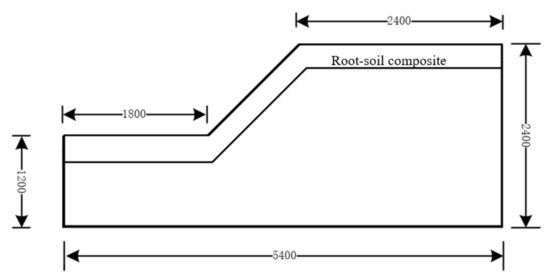
Figure 4.
The geometrical parameters for slope modeling (unit: cm).
By changing the thickness of the root–soil composites, and the corresponding c and φ (Table 2), the FS in the different growth periods was assessed. Specifically, the thickness of the root–soil composite under M.m was set at 0.4 m, 0.6 m, 0.8 m and 1.0 m during the four growth periods, while under C.d it was 0.06 m, 0.18 m, 0.24 m, and 0.30 m.
4.2.2. Numerical Model Working Conditions
The numerical simulation analysis of slope stability was conducted under different conditions, as shown in Table 3. Four sampling time points of 30 d, 60 d, 90 d, and 120 d were chosen for the experiment. Therefore, the thickness of the root–soil composites varied during different growth periods of the vegetation species. The root depths of C.d and M.m at the four different sampling time points were assumed to be 0.06 m, 0.18 m, 0.24 m, 0.30 m and 0.4 m, 0.6 m, 0.8 m, 1.0 m, respectively. The factor of safety of the different working conditions was calculated using the strength reduction method.

Table 3.
Simulated conditions.
4.3. Vegetated Slope Stability Analysis
4.3.1. FS
To study the impact of growth period on slope stability, the results of FS were recorded, as shown in Table 4 and Figure 5. The FS of the bare slope was 1.48, while the FS values of the C.d root-reinforced slope in the different growth periods were 1.51, 1.57, 1.59 and 1.60, respectively. Compared with the bare slopes, the FS increased by 1.7% to 8%. The FS values of the M.m root-reinforced slope in the different growth periods were 1.53, 1.60, 1.64 and 1.66, respectively. The FS increased by 3.3% to 11.9%. The FS values of the G.s mixture root-reinforced slope in the different growth periods were 1.55, 1.62, 1.67 and 1.72, respectively, which increased by 4.5% to 15.7%. All vegetated slopes were more stable than the bare slope. This is due to the fact that as the growth period increased, the roots increased the ability of the vegetation to reinforce the slope. Comparing the three vegetated slopes, the G.s mixture had the best reinforcement effect. Therefore, the reinforcement effect of the G.s mixture plants could be used in slope engineering to improve slope stability.

Table 4.
Slope stability results under different conditions.

Figure 5.
Slope stability results. (a) The FS values of C.d; (b) the FS values of M.m; (c) the FS values of G.s.
4.3.2. Displacement
To illustrate the effect of the root–soil composites of C.d, M.m, and G.s on the slope displacement, the maximum horizontal and vertical displacements were analyzed. The simulation results are shown in Table 5 and Figure 6. The results show that the vertical displacements of both the bare and vegetated slopes were significantly greater than the horizontal displacements. According to the statistical results, the vertical displacement was 13.9 to 22 times that of the horizontal displacement. Additionally, the horizontal and vertical displacements of the C.d, M.m and G.s mixture slopes were significantly less than the bare slope. The displacement could be effectively reduced under the action of the root system in the four different growth periods of C.d, M.m and G.s mixture. As the growth period increased, the maximum horizontal and vertical displacements further decreased. This suggests that plant roots play an important role in the soil-shearing process. Through the anchoring effect of deep root systems and the reinforcement effect of shallow root systems, the horizontal and vertical displacements are affected, thus improving the shear strength. The shear strength mainly affects the horizontal shear force of the soil; hence, the reduction in the horizontal displacement is greater than in the vertical displacement. According to the decreasing degree of horizontal and vertical displacement, this shows that the slope protection effect of the G.s mixture is better.

Table 5.
Maximum horizontal and vertical displacements under different conditions.
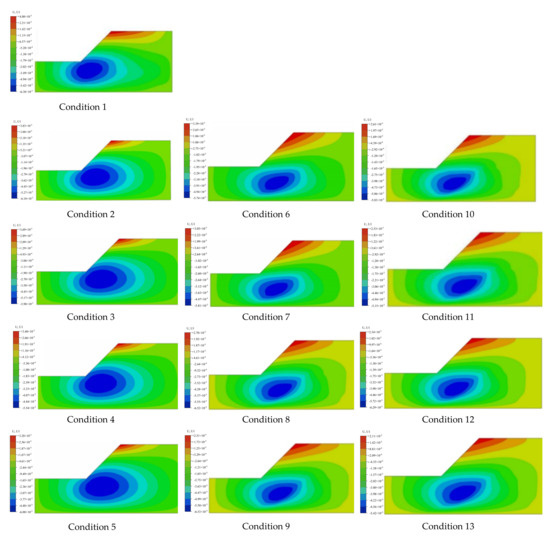
Figure 6.
Nephograms of horizontal displacement under different conditions (unit: m).
4.3.3. Plastic Strain
The equivalent plastic strain (EPS) and maximum equivalent plastic strain under different conditions were calculated by the SRM, as shown in Table 6 and Figure 7. It can be seen that the maximum plastic strain causing slope instability occurred at the foot of the slope and was mainly concentrated in that area, indicating a shallow failure. Compared with the bare slopes, the root–soil composites of C.d, M.m and the G.s mixture in the different growth periods reduced the maximum EPS by 11.5 to 38.5%, 16.3% to 53.8% and 21.2% to 63.5%, respectively. The reduction in EPS increased with the growth of the roots, demonstrating that the root–soil composites of C.d, M.m and G.s had a significant effect on reducing the plastic strain of the slope.

Table 6.
Maximum equivalent plastic strain at slope failure.
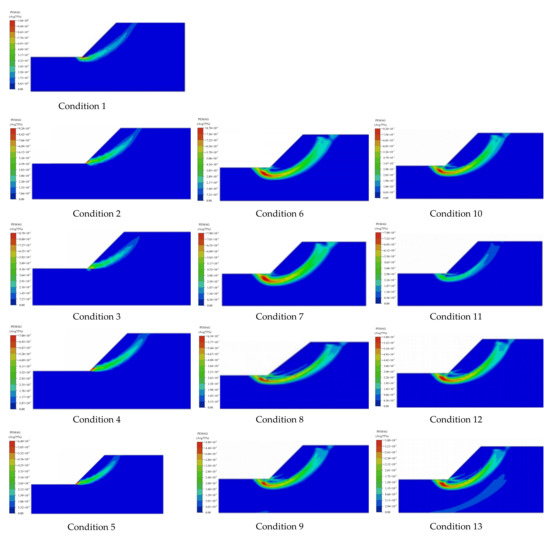
Figure 7.
Nephogram of the equivalent plastic strain magnitude (PEMAG) at slope failure.
When comparing the slip surfaces of the bare, C.d, M.m, and G.s mixture slopes, it was found that the plastic zone gradually moved to the depth of the slope as the growth period increased. The concentrated area of plastic deformation gradually moved away from the foot of the slope. These results show that the root system of the G.s mixture can strengthen the control of soil deformation in shallow slopes more effectively, make the soil deformation area move towards the deep layers, and increase the shallow slope stability.
5. Conclusions
In this study, the mechanical properties of root–soil composites under different plants and their effects on slope stability were studied. The effects of soil reinforcement by plants in different growth periods on slope stability were analyzed. Conclusively, the shear strengths of the root–soil composites all conformed to the Mohr–Coulomb criterion, and they were considerably higher than that of the bare soil. The presence of roots significantly enhanced the shear strength of soil, and the reinforcement effect varied with the type of plant and its growth period. The root–soil composite containing the G.s mixture was a more effective way of improving slope stability compared to using single herb or shrub root reinforcement. Vegetation covers could improve slope stability. The factor of safety of the slope increased as the growth period increases. However, the extent of plant root reinforcement soil is limited, as the maximum factor of safety only increased by 15.7% for the three different slope protection modes. In future, the hydraulic effect of vegetation covers on slope stability could be conducted to further explore the mechanisms of ecological protection.
Author Contributions
Conceptualization, X.Z. and H.X.; methodology, X.Z. and J.W.; software, D.F., X.H., Z.L. and Q.D.; validation, X.Z., J.W. and H.X.; writing—review and editing, X.Z., D.F., J.W. and H.X.; funding acquisition, X.Z. and H.X. All authors have read and agreed to the published version of the manuscript.
Funding
This research was funded by the National Natural Science Foundation of China (52108315, 52078195), the Natural Science Foundation of Hubei Province of China (2021CFB286), the Youth Science and Technology Research Program of Hubei Education Department (Q20211404), the Joint Funds of the National Nature Science Foundation of China (U22A20232), and the Research Fund for the Doctoral Program of Hubei University of Technology (BSQD2020052).
Institutional Review Board Statement
Not applicable.
Informed Consent Statement
Not applicable.
Data Availability Statement
Some or all of the data, models, or code that support the findings of this study are available from the corresponding author upon reasonable request.
Conflicts of Interest
The authors declare no conflict of interest.
References
- Lian, B.; Peng, J.; Zhan, H.; Wang, X. Mechanical response of root-reinforced loess with various water contents. Soil Tillage Res. 2019, 193, 85–94. [Google Scholar] [CrossRef]
- Hess, D.M.; Leshchinsky, B.A.; Bunn, M.; Mason, H.B.; Olsen, M.J. A simplified three-dimensional shallow landslide susceptibility framework considering topography and seismicity. Landslides 2017, 14, 1677–1697. [Google Scholar] [CrossRef]
- Oorthuis, R.; Vaunat, J.; Hürlimann, M.; Lloret, A.; Moya, J.; Puig-Polo, C.; Fraccica, A. Slope orientation and vegetation effects on soil thermo-hydraulic behavior. An experimental study. Sustainability 2021, 13, 14. [Google Scholar] [CrossRef]
- Ji, J.; Kokutse, N.; Genet, M.; Fourcaud, T.; Zhang, Z. Effect of Spatial Variation of Tree Root Characteristics on Slope Stability. A Case Study on Black Locust (Robinia Pseudoacacia) and Arborvitae (Platycladus Orientalis) Stands on the Loess Plateau, China. Catena 2021, 92, 139–154. [Google Scholar] [CrossRef]
- Xu, Y.; Su, C.; Huang, Z.; Yang, C.; Yang, Y. Research on the Protection of Expansive Soil Slopes under Heavy Rainfall by Anchor-Reinforced Vegetation Systems. Geotext. Geomembr. 2022, 50, 1147–1158. [Google Scholar] [CrossRef]
- Ajedegba, J.O.; Choi, J.W.; Jones, K.D. Analytical modeling of coastal dune erosion at South Padre Island: A consideration of the effects of vegetation roots and shear strength. Ecol Eng. 2019, 127, 187–194. [Google Scholar] [CrossRef]
- Giadrossich, F.; Schwarz, M.; Cohen, D.; Preti, F.; Or, D. Mechanical Interactions between Neighbouring Roots during Pullout Tests. Plant Soil 2013, 367, 391–406. [Google Scholar] [CrossRef]
- Zhu, H.; Zhang, L.M.; Xiao, T.; Li, X.Y. Enhancement of Slope Stability by Vegetation Considering Uncertainties in Root Distribution. Comput. Geotech. 2017, 85, 84–89. [Google Scholar] [CrossRef]
- Chok, Y.H.; Jaksa, M.B.; Kaggwa, W.S.; Griffiths, D.V. Assessing the Influence of Root Reinforcement on Slope Stability by Finite Elements. Int. J. Geo-Eng. 2015, 6, 12. [Google Scholar] [CrossRef]
- Hongde, W.; Dongli, S.; Xiaoqin, S.; Shengqiang, T.; Yipeng, Z. Analysis of unsaturated shear strength and slope stability considering soil desalinization in a reclamation area in China. Catena 2021, 196, 104949. [Google Scholar] [CrossRef]
- Fan, C.C.; Tsai, M.H. Spatial distribution of plant root forces in root-permeated soils subject to shear. Soil Tillage Res. 2016, 156, 1–15. [Google Scholar] [CrossRef]
- Xing, S.; Zhang, G.; Zhu, P.; Wang, L.; Wang, Z.; Wang, C. Variation in shear strength of soil-root system under five typical land use types on the Loess Plateau of China. Catena 2023, 222, 106883. [Google Scholar] [CrossRef]
- Xiong, D.; Chen, F.; Lv, K.; Tan, X.; Huang, Y. The performance and temporal dynamics of vegetation concretes comprising three herbaceous species in soil stabilization and slope protection. Ecol. Eng. 2023, 188, 106873. [Google Scholar] [CrossRef]
- Taib, A.M.; Taha, M.R.; Abd Rahman, N.; Yazid, M.R.M.; Khoiry, M.A. The Effect of Soil-Root Interaction by Vetiver Grass on Slope Stability. J. Eng. Sci. Technol. 2020, 15, 46–57. [Google Scholar]
- Guo, P.; Xia, Z.; Liu, Q.; Xiao, H.; Gao, F.; Zhang, L.; Li, M.; Yang, Y.; Xu, W. The mechanism of the plant roots’ soil-reinforcement based on generalized equivalent confining pressure. PeerJ 2020, 8, e10064. [Google Scholar] [CrossRef]
- Emadi-Tafti, M.; Ataie-Ashtiani, B.; Hosseini, S.M. Integrated impacts of vegetation and soil type on slope stability: A case study of Kheyrud Forest. Iran. Ecol. Modell. 2021, 446, 109498. [Google Scholar] [CrossRef]
- Fattet, M.; Fu, Y.; Ghestem, M.; Ma, W.; Foulonneau, M.; Nespoulous, J.; Le Bissonnais, Y.; Stokes, A. Effects of vegetation type on soil resistance to erosion: Relationship between aggregate stability and shear strength. Catena 2011, 87, 60–69. [Google Scholar] [CrossRef]
- Xia, S.; Brierley, G.; Zhu, H.L.; Li, G.R.; Fu, J.T.; Mao, X.Q.; Yu, Q.Q.; Qiao, N. An Exploratory Analysis of Vegetation Strategies to Reduce Shallow Landslide Activity on Loess Hillslopes, Northeast Qinghai-Tibet Plateau, China. J. Mt. Sci. 2013, 10, 668–686. [Google Scholar] [CrossRef]
- Loades, K.W.; Bengough, A.G.; Bransby, M.F.; Hallett, P.D. Planting Density Influence on Fibrous Root Reinforcement of Soils. Ecol. Eng. 2010, 36, 276–284. [Google Scholar] [CrossRef]
- Huang, M.; Sun, S.; Feng, K.; Lin, M.; Shuai, F.; Zhang, Y.; Lin, J.; Ge, H.; Jiang, F.; Huang, Y. Effects of Neyraudia reynaudiana roots on the soil shear strength of collapsing wall in Benggang, southeast China. Catena 2022, 210, 105883. [Google Scholar] [CrossRef]
- Lin, H.D.; Wang, W.C.; Li, A.J. Investigation of dilatancy angle effects on slope stability using the 3D finite element method strength reduction technique. Comput. Geotech. 2020, 118, 103295. [Google Scholar] [CrossRef]
- Sun, G.; Lin, S.; Zheng, H.; Tan, Y.; Sui, T. The virtual element method strength reduction technique for the stability analysis of stony soil slopes. Comput Geotech. 2020, 119, 103349. [Google Scholar] [CrossRef]
- Zou, J.; Yang, F.; Yuan, W.; Liu, Y.; Liu, A.; Zhang, W. A kinetic energy-based failure criterion for defining slope stability by PFEM strength reduction. Eng. Fail. Anal. 2023, 145, 107040. [Google Scholar] [CrossRef]
Disclaimer/Publisher’s Note: The statements, opinions and data contained in all publications are solely those of the individual author(s) and contributor(s) and not of MDPI and/or the editor(s). MDPI and/or the editor(s) disclaim responsibility for any injury to people or property resulting from any ideas, methods, instructions or products referred to in the content. |
© 2023 by the authors. Licensee MDPI, Basel, Switzerland. This article is an open access article distributed under the terms and conditions of the Creative Commons Attribution (CC BY) license (https://creativecommons.org/licenses/by/4.0/).